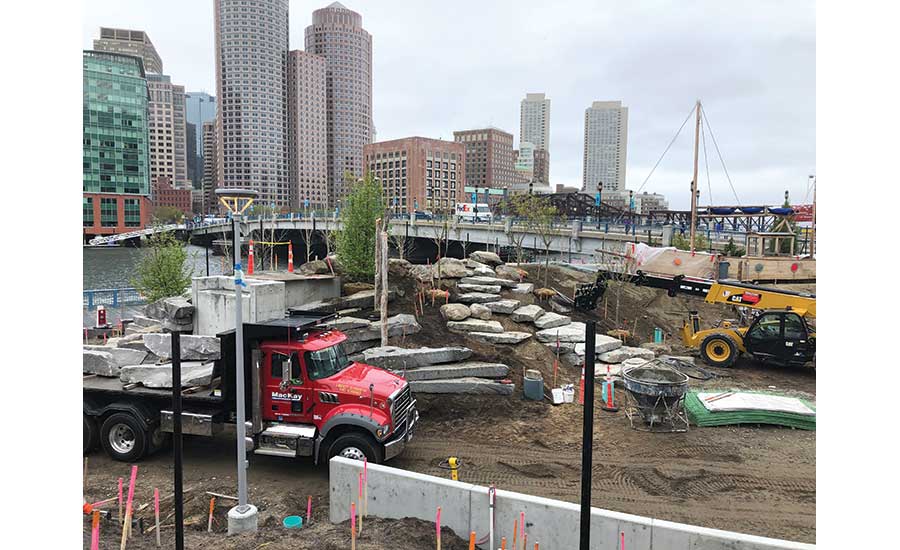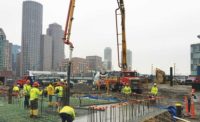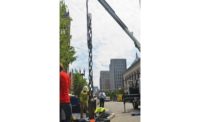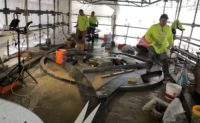Martin’s Park, a playground in memory of those killed in the 2013 Boston Marathon bombing, opened on June 15. The estimated $15-million park is named for Martin Richard, age 8. Designed by landscape architect Michael Van Valkenburgh Associates and built by MacKay Construction Services Inc., the 1-acre site is wheelchair-accessible, with natural elements such as logs and rocks scattered across an undulating topography. It includes a 40-ft by 12-ft custom wood pirate ship fabricated in Germany and a series of one-story-tall slides with city views. Delayed by bad weather and redesigned for resilience, the two-year project also includes a 35-ft-long pedestrian bridge.
Much of the $8 million in private fundraising is thanks to Martin’s family, including his father, Bill Richard, who was a vice president at environmental engineering firm EST Associates in Needham, Mass. until 2016 when he left to focus on the Martin Richard Foundation. Richard was injured, along with his wife and a daughter, who lost a leg. Richard could not be reached.
“Martin’s Park will be a symbol of Martin’s welcoming, inclusive nature as well as his idea of an ideal park,” Martin’s family posted in a letter published on the Martin Richard Foundation website announcing the park’s opening. “This unique, public, outdoor space will ensure that Martin’s legacy remains a vibrant and positive influence for future generations.”
Seen as a model for resilience, Democratic presidential candidate and former vice president, Joe Biden, toured the site on June 5 with Boston Mayor Martin J. Walsh. “There’s no way we deal with resiliency issues … other than making significant, significant investment,” Biden—who has proposed $1.7 trillion federal investment in clean energy during the next decade to go along with another $3.3 trillion in private, state and local investments—told the Boston Herald.
After Biden’s visit, Walsh tweeted, “This new inclusive playground will protect the Seaport from sea level rise and flooding. We look forward to its opening on 06/15!”
Resilience reboot
Portions of the park were redesigned after it was flooded during a series of unprecedented and unseasonal nor’easters that battered Massachusetts in the winter and spring of 2018. Shortly after the storms, the city raised South Boston’s flood elevation requirements as part of the mayor’s Climate Ready Boston initiative. Originally designed with flood elevation requirements based on the Federal Emergency Management Agency maps, redesigning the park to the new requirements, combined with bad weather, added about six months to the schedule.
Fortunately, the team already installed drainage before the Jan. 4 storm known as the “Bomb Cyclone” flooded the site, and the team had not yet installed geofoam blocks below grade and above an existing Massachusetts Bay Transportation Authority Silver Line tunnel. The redesign added piles and a structural slab underneath the geofoam, “so it could never float out of the ground,” says James MacKay, president and owner of MacKay Construction Services Inc.
Forty-two minipiles—each 90 ft long and 7.5 inch dia.—drilled in two rows support the footings of the retaining walls and Harborwalk seating along the park’s west side. "A portion of the new retaining wall toward the north side of the park was installed without geofoam or piles, but on compacted subgrade,” says Chris Donohue, associate principal at Michael Van Valkenburgh. “This was only possible in areas directly over the MBTA Silver Line Tunnel, where construction from the tunnel was backfilled with dense grade capable of supporting the load.”
MacKay likes to say the fact that the city was hit with a historic storm two months before geofoam was scheduled be placed means “Martin’s looking down on us … it makes you think there is good going on … the whole job has gone like that, everything has fallen into place.”
More bad weather
After surviving the 2018 storms, the project team, however, was unable to complete the park in time for the 2019 Boston Marathon on April 15 due to this year's rainiest fall and spring on record. MacKay says the team then turned its attention to opening in June because Martin’s birthday is June 9.
With 21 rain days in April, MacKay says the team was fortunate that the design called for exposed aggregate sidewalks, which requires pressure washing the finish. “If you were doing traditional broom sidewalks you’d be 21 days behind schedule because you can’t pour regular sidewalks with incoming showers,” says MacKay, who added that grading the sidewalks was complicated by the fact that pressure washing is difficult for cement masons and finishers to control. “It really was tricky to get it not only aesthetically pleasing to the eye but also [Americans with Disabilities Act] compliant.”
MacKay praised city officials for giving the team flexibility to work during breaks in the rain, even on weekends when streams of family’s flock to the adjacent Boston Children’s Museum. He says he's “overwhelmed” by support from the community, mayor, governor and Martin’s parents, who regularly bring craft workers coffee and donuts and hooded sweatshirts and t-shirts from the Martin Richard Foundation. Bill Richard also regularly texted MacKay late at night to say the “project was coming along nicely.”
Coincidentally, the Boston Marathon Bombing Memorial on Boylston Street is also scheduled to turn over later this summer. “You don’t want to have one overshadow the other,” MacKay says. “They’re both important. That’s where the tragedy happened, and [the park] is where we’re going to celebrate what we made of such a negative thing.”
New information was added to this story on June 14. A version of this story appears in the June 17 issue of ENR.







